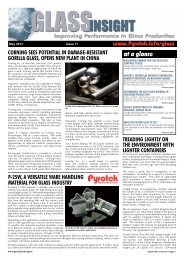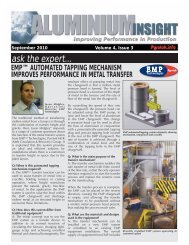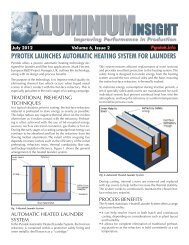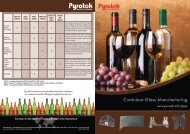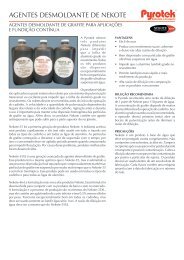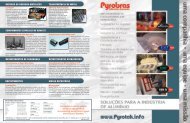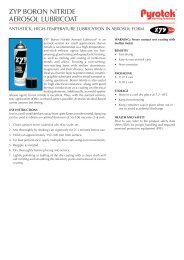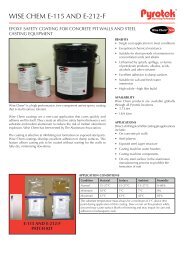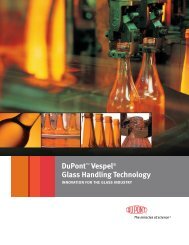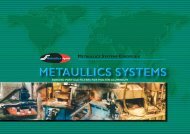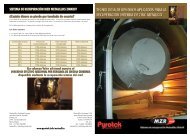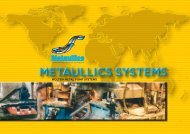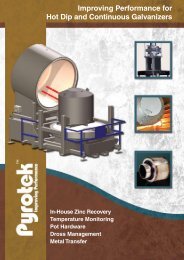RFM Boosts Productivity for Nissan Casting Plant - Pyrotek
RFM Boosts Productivity for Nissan Casting Plant - Pyrotek
RFM Boosts Productivity for Nissan Casting Plant - Pyrotek
Create successful ePaper yourself
Turn your PDF publications into a flip-book with our unique Google optimized e-Paper software.
September July 2012 2008 Volume Volume 6, Issue 2, 2 Issue 3<strong>RFM</strong> ® boosts productivity <strong>for</strong> <strong>Nissan</strong><strong>Casting</strong> <strong>Plant</strong>The <strong>Nissan</strong> casting plant in Australia, located in the Melbournesuburb of Dandenong, Victoria, is an important longstandingcustomer <strong>for</strong> <strong>Pyrotek</strong> in the foundry sector.The casting plant, operated by <strong>Nissan</strong> Motor Co. (Aust.) Pty.Ltd., processes around 8000 t/yr of aluminium to producearound 2.5 million individual automotive components peryear. The plant exports most of its parts to <strong>Nissan</strong> factories inJapan, Thailand, Mexico and the USA.It operates eight high-pressure UBE diecasting machines,one low-pressure diecasting machine and several CNCmachining centres, manufacturing components mainly <strong>for</strong><strong>Nissan</strong> vehicles, including notably the new first zero emissionfive door family hatch electric car “Leaf” model.By late 2013, the <strong>Nissan</strong> casting plant is expected to beproducing 22,000 electric vehicle components per month,contributing to <strong>Nissan</strong>’s global leadership in zero emissionvehicle technology.The <strong>Nissan</strong> <strong>Casting</strong> <strong>Plant</strong> customer had traditionally usedcast iron autopour ladles in the high-pressure UBE castingmachines, which were proving to be problematic in terms oflost productivity through excessive downtime, maintenancerequirements, and short service life. These problems weregenerating a production bottleneck and <strong>Nissan</strong> invited<strong>Pyrotek</strong> to review their process and identify areas <strong>for</strong>improvement.In close cooperation with <strong>Nissan</strong> personnel, a detailedprocess assessment was undertaken through the second halfof 2011 by Sales Engineer, Delia Avram, based at <strong>Pyrotek</strong>’sDandenong, Australia office.Customer painDelia noted that the cast iron autopour ladles in use requireddaily coating, and on every shift the casting machines had tobe stopped <strong>for</strong> intensive cleaning to remove skull buildup.These ladles also required changing on a weekly basis. Thesefactors together generated a significant loss of productivity.Following a careful survey of the process parameters inactual production trials, and considering the customer’srequirements to improve productivity and efficiency, <strong>Pyrotek</strong>proposed that in place of the cast iron ladles, an optimum®<strong>RFM</strong>solution was to use <strong>RFM</strong> ® ladles coated with ZYP BoronNitride (BN) Releasecoat ® .<strong>Nissan</strong> accepted these proposals and in August 2011,<strong>Pyrotek</strong> supplied two <strong>RFM</strong> AutoPour ladles <strong>for</strong> trial. Oneladle was mounted on the 800 UBE casting machine withthe second on the 1250 UBE. Both casting stations were torun in parallel.Improved per<strong>for</strong>manceIn September 2011, after a four-week campaign, maintenancewas carried out on both ladles, including cleaning of scull,coating with BN hardcoat and BN releasecoat blue. The linewas back in service the following day.In October 2011, after eight weeks, a second maintenancecycle was carried out, again on both ladles, with the samecoating treatments and return to service twenty-four hourslater.By December 12, 2011, after sixteen weeks the ladle on theUBE 800 machine was taken out of service because the <strong>RFM</strong>material around the steel bracket had been badly damaged.By the end this campaign, 60,550 shots were recorded.By the next day, the UBE 1250 machine was out of service,with the <strong>RFM</strong> material showing damage around the steelband area, and under the pouring lip. The total sixteen-weekcampaign had produced 77,600 shots.Changing to <strong>RFM</strong> material has clearly resulted in improvedper<strong>for</strong>mance <strong>for</strong> the customer by increasing productivity anddelivering cost savings.Customer SavingsAlthough it is not possible to compute exact cost savingsrealised <strong>for</strong> <strong>Nissan</strong>, these are estimated at betweenUSD$10,000–15,000 solely <strong>for</strong> the ladles. This does notinclude the cost savings due to the new coatings and thereduced downtime, which eliminated the need <strong>for</strong> a dailycoating operation, and weekly change-out of the cast ironladles.The <strong>Nissan</strong> casting plant campaign clearly highlightsthe improved per<strong>for</strong>mance of the <strong>RFM</strong> material and theproductivity increases that resulted. This led to an order <strong>for</strong>regular supply of these components.<strong>Pyrotek</strong> now supplies the <strong>Nissan</strong> casting plant with AutoPour
ladles in 8 kg (17.6 lb) and 13 kg (28.6 lb) capacities, in <strong>RFM</strong>material and coated with ZYP Boron Nitride Releasecoat.These products are specially manufactured at <strong>Pyrotek</strong>’sBlansko facility in the Czech Republic.<strong>Pyrotek</strong> plans to begin trials with <strong>RFM</strong> launders <strong>for</strong> the dosingfurnaces: 1880 mm (74 inch) long <strong>for</strong> four of the customer’sfurnaces and 1600 mm (63 inch) long <strong>for</strong> their other furnace.<strong>RFM</strong> ladle with BN coatingLadle in operation



